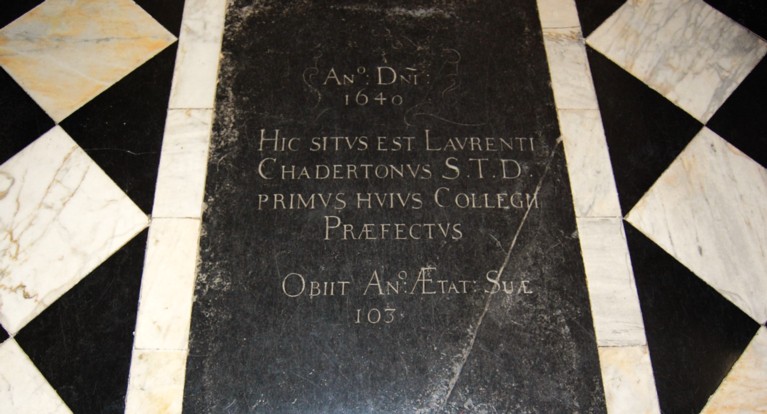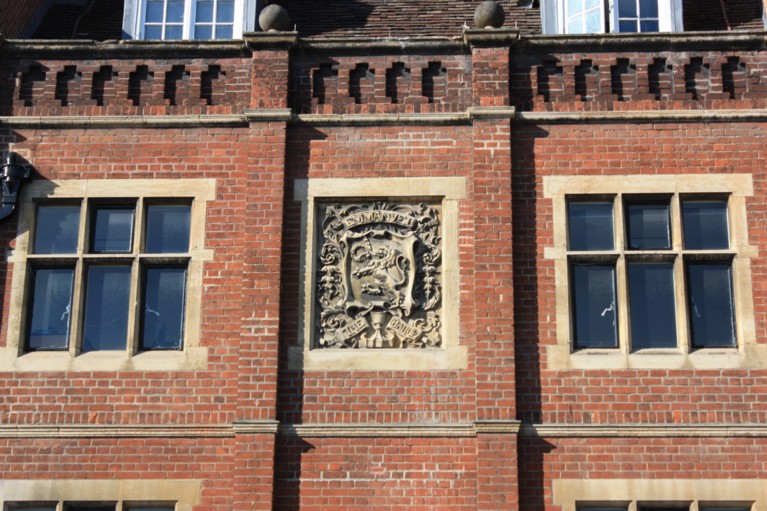Blog
29 May 2024
C is for … Chaderton

Laurence Chaderton, the first Master of Emmanuel, was a most remarkable man. His father Thomas, a minor landowner from Oldham, was a Roman Catholic, who cut off his son with the proverbial shilling when the young man embraced the Protestant faith. By the time Laurence became Master here, in 1584, he was one of the most renowned preachers of his day, possessing a ‘wonderful zeal for winning souls’. On one occasion, after a two-hour sermon, his enthralled congregation were said to have begged: ‘for God’s sake sir, go on!’. Sir Walter Mildmay thought so highly of him that his founding of Emmanuel College was contingent on Chaderton’s accepting the mastership. This he did, despite having received an offer of a more lucrative ecclesiastical appointment, and for 38 years he administered the college with ‘fidelity, prudence, and industry’. Even after relinquishing the mastership in 1622, when he was in his eighties, he continued to play an active role in college affairs. Widely respected and loved for his ‘active and fearless, and yet kindly and liberal’ spirit, Chaderton was sought out by many distinguished visitors to Cambridge, including King James I & VI and his son, Prince Charles. The King went further, by appointing him one of the authors of the 1611 Authorised Version of the Bible; he helped translate the section from 1 Chronicles to the Song of Solomon. Chaderton died in November 1640, at the great age of either 101 or 104 (he gave differing accounts of his year of birth, but either way his tombstone inscription is incorrect). According to his daughter, Elizabeth, he remained astonishingly robust until suffering the fall that brought on his death. He was buried in the original college chapel, and re-interred in the new one after its consecration in 1677.
C is for … Chalice

Above the shop frontage of 21 St Andrew’s Street, Cambridge, directly opposite the junction with Emmanuel Street, a fine sculpted stone panel can be seen. It shows our college coat of arms, with the name ‘Emmanuel’ above and a carving of a goblet below, along with the words ‘The Chalice’. This tenement came to Emmanuel in 1585, one of several similar gifts and bequests bestowed upon the new college by generous benefactors. Most of these donors were what we would now call Puritans, who approved of the college’s founding ethos, but this was not the case with the owner of the Chalice. It was bequeathed to the college by Henry Harvey, Doctor of Laws, Master of Trinity Hall, Canon of Ely, and a prominent University man. In negotiating the political upheavals of the mid-sixteenth century, Harvey’s religious views embraced a degree of flexibility that the Vicar of Bray might have admired. As it seems unlikely, however, that he was ever a genuinely enthusiastic Puritan, his bequest of the Chalice to Emmanuel College would seem to be a mark of his personal regard for either Sir Walter Mildmay or Laurence Chaderton. All that can be said for certain, though, is that Doctor Harvey had helped with the complex legal procedures attaching to Mildmay’s acquisition of the college site in 1584. The title deeds to 21 St Andrew’s Street are held in our archives. They date back to 1295, but the earliest document in which the tenement is named ‘Chalice’ is a conveyance of 1578, which calls it a ‘messuage or ynne called the Challyce’. Later converted to a mixture of residential and retail occupancy, the property was completely rebuilt in 1895.
Amanda Goode, College Archivist
